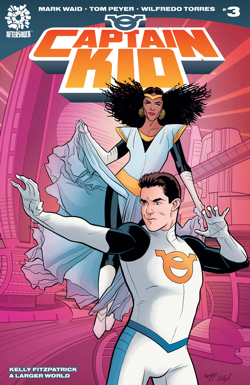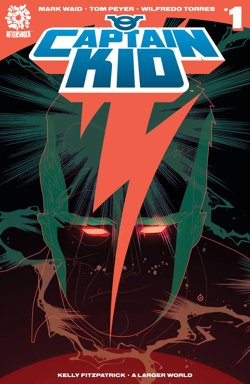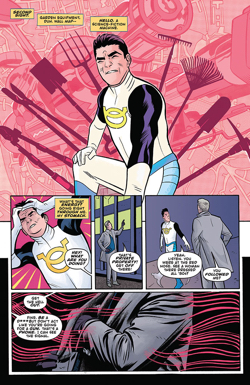Joe Corallo: AfterShock Gets It!
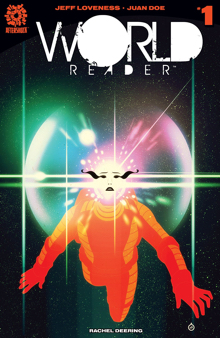 In the past I’ve mentioned some of what AfterShock Comics has been up to in my column here, but I haven’t talked about them as much as I should. I really haven’t been talking about the good work they’ve been doing. Having recently read World Reader #1, I decided I need to change that.
In the past I’ve mentioned some of what AfterShock Comics has been up to in my column here, but I haven’t talked about them as much as I should. I really haven’t been talking about the good work they’ve been doing. Having recently read World Reader #1, I decided I need to change that.
AfterShock Comics gets it.
I’ll explain. I was having lunch with Noah Sharma who writes over at Weekly Comic Book Review and AfterShock dominated the conversation. We talked about the different titles we’ve been enjoying like InSEXts, Animosity, Captain Kid, and World Reader. Well, the conversation actually started when I brought up how much I loved World Reader so let me backpedal a bit and talk about World Reader.
World Reader #1 hit the shelves on April 19th. It’s written by Jeff Loveness, drawn by Juan Doe and lettered by Rachel Deering. Jeff Loveness is best known for being a writer on Jimmy Kimmel Live! as well as writing Groot over at Marvel. This is his first creator owned comic. Juan Doe has worked on many comics over the years including American Monster and Animosity also at AfterShock. on Rachel Deering worked on the Womantholoy.
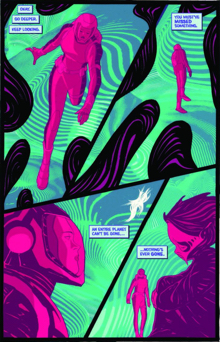 Basically, World Reader is about an astronaut, Sarah, who travels around the universe trying to help figure out what is seemingly killing it. She’s helped in this effort by her ability to commune with the dead, whether she wants to or not. We read on as Sarah is pushed to limits of her own mind in her quest to save us all.
Basically, World Reader is about an astronaut, Sarah, who travels around the universe trying to help figure out what is seemingly killing it. She’s helped in this effort by her ability to commune with the dead, whether she wants to or not. We read on as Sarah is pushed to limits of her own mind in her quest to save us all.
For being the first creator-owned effort by Jeff Loveness, it’s fantastic. We really get sucked into this dangerous world and Jeff is humble enough to not overload the book with dialogue when it’s not necessary. He lets the art tell the story. And damn, it’s a good story.
This is a good story is because of Juan Doe’s artwork and colors. This book pops in a way that most books just don’t. I’d say that Jeff wrote a hell of a page turner, but the book is so gorgeous that turning the page might be the last thing you want to do.
What helps push you to turn the page is Rachel Deering’s excellent lettering. It’s not often that the lettering in a comic pops just like the art does, but Rachel makes it happen.
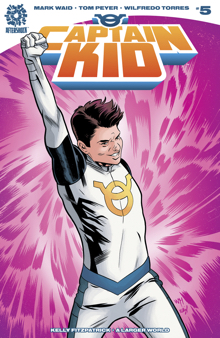 This team really feels like lightning in a bottle and I truly feel like they are onto something here. I haven’t felt this excited to pick up a second issue in a while. If I’m picking up a second issue of a comic then, yes, I’m at least somewhat excited, or curious, or trying to give it a chance to let the story unfold, but here I’m pretty damn excited.
This team really feels like lightning in a bottle and I truly feel like they are onto something here. I haven’t felt this excited to pick up a second issue in a while. If I’m picking up a second issue of a comic then, yes, I’m at least somewhat excited, or curious, or trying to give it a chance to let the story unfold, but here I’m pretty damn excited.
I admit that I’m a science fiction fan so maybe the kind of story they’re setting up here appeals to me more than it might to someone else, but anyone that likes sci-fi comics needs to pick up World Reader. Don’t think about it, don’t add it to your list, don’t put it in your big stack of comics that’s months old now that you just don’t know when you’ll get to it, read it! If you’re afraid if you get home with it it’ll end up in a pile then read it outside the comic shop when you get a chance, or in your car before you drive away, or put aside the eight minutes when you buy it on ComiXology when you buy it to read it right then and there. If you don’t normally like sci-fi, but you like pretty books with fantastic colors, you should give this a shot too.
What was I talking about? Oh, yeah! Lunch with Noah. So I talk about how I picked up World Reader #1 from Carmine Street Comics in Manhattan and after talking about how much I enjoyed it, we got talking about AfterShock in general. We talked about InSEXts and Marguerite Bennett and how that’s been absolutely fantastic, original, and one of the best books she’s writing. For me, it’s a flagship title for AfterShock, and a book they should be immensely proud of publishing. Animosity I haven’t gotten a chance to read, but it’s on my list. Yes, I’m being that person that I said you shouldn’t be about World Reader. I’m working on it, really!
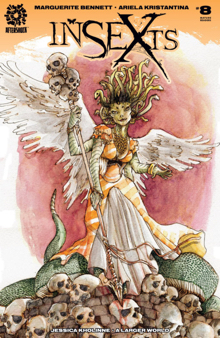 One of the other books I really enjoyed that AfterShock puts out is Captain Kid. ComicMix’s own Ed Catto wrote about this book the end of last year, and I encourage you all to read it if you haven’t yet. Though it’s concluded as of April, it was a fantastic character driven story by creators Mark Waid and Tom Peyer, who oddly enough were both DC editors some years ago. The team includes artists Wilfredo Torres and Brent Peeples, colorist Kelly Fitzpatrick, with A Larger World lettering. The book is about a character that’s a bit of a reverse Shazam (I wish I could call him Captain Marvel) and uses that as a device to create a very personal feeling character piece about aging and coming to terms with your life. It looks and feels like a comic from a time where the stories were a bit simpler, in a good way. If you love the Silver or Bronze Age of comics, or the kind of person who loves groups like DC In The 80s you should read Captain Kid. If you didn’t get a chance while it was coming out, the collected edition comes out in June.
One of the other books I really enjoyed that AfterShock puts out is Captain Kid. ComicMix’s own Ed Catto wrote about this book the end of last year, and I encourage you all to read it if you haven’t yet. Though it’s concluded as of April, it was a fantastic character driven story by creators Mark Waid and Tom Peyer, who oddly enough were both DC editors some years ago. The team includes artists Wilfredo Torres and Brent Peeples, colorist Kelly Fitzpatrick, with A Larger World lettering. The book is about a character that’s a bit of a reverse Shazam (I wish I could call him Captain Marvel) and uses that as a device to create a very personal feeling character piece about aging and coming to terms with your life. It looks and feels like a comic from a time where the stories were a bit simpler, in a good way. If you love the Silver or Bronze Age of comics, or the kind of person who loves groups like DC In The 80s you should read Captain Kid. If you didn’t get a chance while it was coming out, the collected edition comes out in June.
Sorry. I keep getting off track. Lunch… that’s right. So Noah and I ended up talking about these different titles and we come to the conclusion that AfterShock really gets it. Though they’re working with quite a few established writers, they are trying to take some chances. They throw stuff against the wall and see what sticks. Sure, not every title is going to be the next The Walking Dead, and some titles are going to be duds; it happens, but it’s the drive and creativity they have that gives AfterShock Comics the feel that they could be revival Image Comics one day.
Basically, what I’m trying to say is, if you haven’t checked out AfterShock yet, there’s no time like the present.



